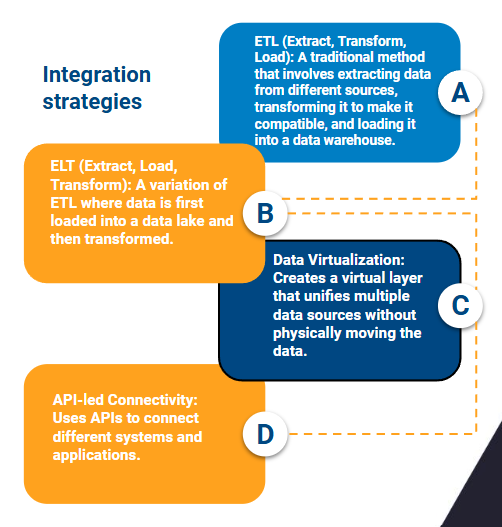
Data Integration Strategies for a Modern Data Architecture
August 19, 2024
Table of contents
Quick Access
In the digital age, organizations are immersed in a sea of data, coming from multiple sources and formats. This data, if managed effectively, can be the fuel that drives innovation and strategic decision-making. However, to harness its full potential, it is necessary to build a solid data architecture and establish efficient integration strategies.
A modern data architecture is more than just a set of technologies; it is a conceptual framework that guides the capture, storage, management, and use of data within an organization. Unlike traditional architectures, modern ones are designed to be flexible, scalable, and able to adapt to changing business needs.
The importance of data integration lies in its ability to provide a unified and consistent view of data, regardless of its origin. By integrating data from diverse sources, organizations can improve decision-making, optimize business processes, increase innovation, and personalize the customer experience.

Integration Strategies
There are various strategies for integrating data, each with its own characteristics and applications. Among the most common are:
- ETL (Extract, Transform, Load): A traditional method that involves extracting data from different sources, transforming it to make it compatible, and loading it into a data warehouse.
- ELT (Extract, Load, Transform): A variation of ETL where data is first loaded into a data lake and then transformed. This strategy is ideal for large volumes of data and exploratory analysis.
- Data Virtualization: Creates a virtual layer that unifies multiple data sources without physically moving the data. This option is ideal for ad hoc queries and rapid analysis.
- API-led Connectivity: APIs are used to connect different systems and applications. This strategy is especially useful for integrating heterogeneous systems and promoting data reuse.
- Data Fabric: A holistic approach that connects all of an organization's data, regardless of where it is located. The data fabric provides an abstraction layer that simplifies data integration and access.

Challenges and Considerations
Implementing an effective data integration strategy is not without its challenges. Data quality, volume, variety, and velocity are critical factors to consider. In addition, managing the diversity of data technologies and platforms, as well as data governance, are key aspects to ensure the success of any integration project.
Tools and Technologies
The market offers a wide range of tools and technologies to implement data integration strategies, from traditional ETL tools to cloud platforms and open source solutions. Choosing the right tools will depend on the specific requirements of each organization.

Future Trends in Data Integration
Data integration is undergoing constant evolution, driven by technological advances and the changing demands of organizations. Among the most notable trends are:
- Artificial Intelligence and Machine Learning: These technologies are revolutionizing the way we integrate and analyze data. Machine learning makes it possible to automate integration tasks, improve data quality, and discover hidden patterns. For example, machine learning algorithms can identify and correct inconsistencies in data, as well as generate predictions and recommendations based on historical data.
- Data Mesh: The traditional approach of a centralized data warehouse is giving way to more decentralized and autonomous data architectures. The data mesh promotes the autonomy of business teams, allowing each team to manage its own data in a more agile and efficient way. This trend aligns with the adoption of microservices and the DevOps culture.
- Graph Databases: Graph databases are ideal for representing and analyzing highly connected and complex data, such as social media, product recommendations, and fraud analysis. By modeling data as a graph, relationships, and patterns can be identified that would be difficult to detect with traditional relational databases.
Challenges and Solutions in Data Integration
Data integration presents unique challenges, but it also offers opportunities to improve the efficiency and effectiveness of organizations. Some of the most common challenges and their solutions include:
- Real-time data integration: The demand for real-time information has increased significantly. To overcome this challenge, it is necessary to implement streaming and event processing technologies, as well as optimize data architectures to minimize latency.
- Cloud data integration: The cloud offers scalability, flexibility, and lower costs for data integration solutions. However, it is important to consider security, governance, and data migration when migrating to the cloud.
- Data integration in hybrid environments: Many organizations have a mix of on-premises and cloud infrastructure. Data integration in these environments requires careful planning and the use of tools that can manage the complexity of multiple environments.
In conclusion, data integration is an essential component of any modern data architecture. By adopting an effective data integration strategy, organizations can unlock the value of their data, improve decision-making, and gain a competitive advantage in an increasingly data-driven marketplace.
We recommend you on video
Related Blogs

Steps for software product development
-9.20.37-a.m.png)
Product Design and Development

Tools for Machine Learning

The Best Data Science Tools in 2025

What is Data Science?
